- Home
- entertainment
- news
- Photos show the biggest must-have fashion item of the last 12 decades
Photos show the biggest must-have fashion item of the last 12 decades
Victoria Montalti

- There are key fashion items from every decade in history that many people wanted to wear.
- Shifts in conservatism made flapper dresses, miniskirts, and power suits monumental.
In the 1900s, many women wore S-bend corsets under their day and evening dresses to create a dramatic hourglass body shape.
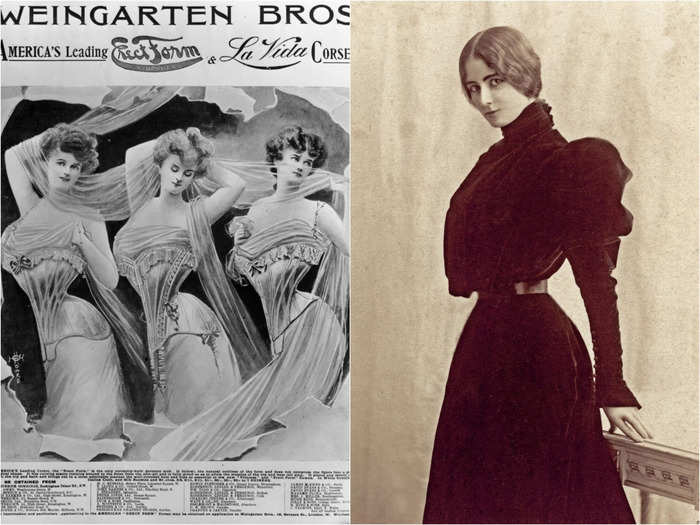
The coveted garment, or more accurately undergarment, of the 1900s was the S-bend corset. The corset got its name from the dramatic tilted S-shape that it forced a woman's body into.
"The S-bend is characterized by a rounded, forward leaning torso with hips pushed back in profile," according to the FIDM Museum.
They were also known as a "health corset" because they were intended to alter one's posture to avoid pressure on the abdomen.
From the front, they gave the appearance of a "mono-bosom." The corset created a chest-heavy silhouette, which was enhanced by flowy tops with dramatic bishop sleeves, along with cinched waists and bell-shaped skirts.
Sitting under silk satin dresses with lace and embellishment, the corset reached its peak in 1905, before more natural silhouettes and the loosening of dresses — notably seen in the next two decades — became prominent.
The coveted (and restrictive) hobble skirt came into fashion in the 1910s, after corsets went out of fashion.
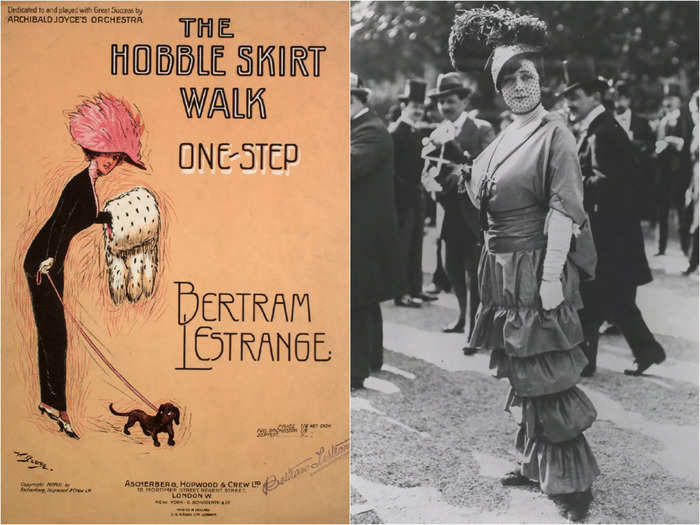
The must-have fashion item of the decade came before WWI started in 1914, and before civilian clothing transitioned into uniforms for the war effort.
French designer Paul Poiret took inspiration from the rise of Orientalism and column silhouettes during the 1910s and popularized the "hobble skirt." The item is known as such because the construction forced women to "hobble" along.
They were "narrow through the ankle and sometimes banded below the knee, constricting women's movement," according to Yahoo. And although silhouettes were looser and didn't require corsets anymore, this piece was very restricting and required taking "geisha-like steps."
With the war starting, women switched to wearing tunics over skirts or overalls while they worked in munition factories. When it ended in 1918, "skirts were still long, but an attempt was made to confine the body in a cylinder," according to FIT.
Women's curves were hidden in tubular flapper dresses with low waistlines during the '20s.
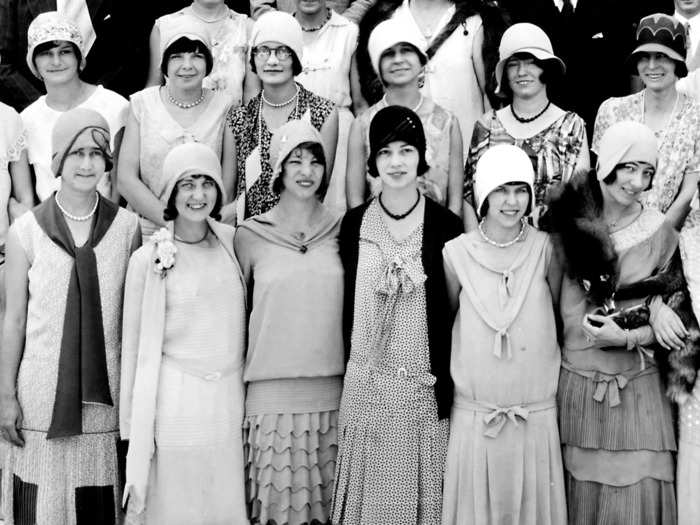
The most iconic and enduring image of the 1920s is still a flapper, which was also the name of the dress style popularly worn by young, working-class city girls.
The flapper or "la garçonne" dress is tubular. Its waistlines and hemlines may have risen and fallen throughout the decade, but they always maintained the iconic silhouette.
These shapeless dresses were simple but glamorous, and evening-wear renditions famously added a little glitz.
"The development of a more convenient, modern female wardrobe was a major trend of the 1920s and was achieved through the progressive simplification of dress," and the economic materials used led to what was known as "the democratization of fashion," according to the Fashion Institute of Technology (FIT).
Throughout the decade, designer Coco Chanel helped popularize this simple yet elegant style.
In the '30s, silky bias-cut gowns hugged and celebrated women's natural curves for the first time.
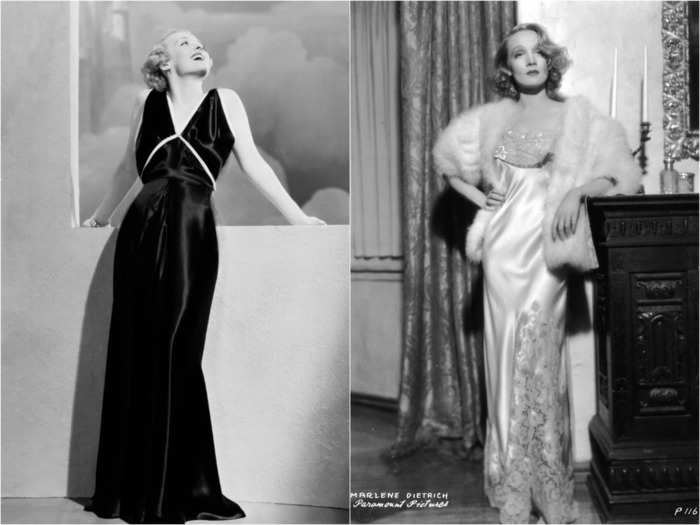
After the onset of the Great Depression in 1929, a rise in escapism led to women emulating movie stars like Marlene Dietrich, Bette Davis, Joan Crawford, and Greta Garbo, who each had glamorous styles that influenced the masses.
The most popular Hollywood-worthy garments of the 1930s were bias-cut gowns. "To cut fabric on the bias means cutting the fabric 45 degrees against the weave, creating a fluid, body-skimming garment," according to FIT.
This fluid silhouette hugged and celebrated feminine curves, unlike dresses from the previous decade. These long, slender, silky evening dresses also sometimes included shoulder pads.
During the '40s, utility clothing was just as common for working in factories as it was for everyday wear or even special events.
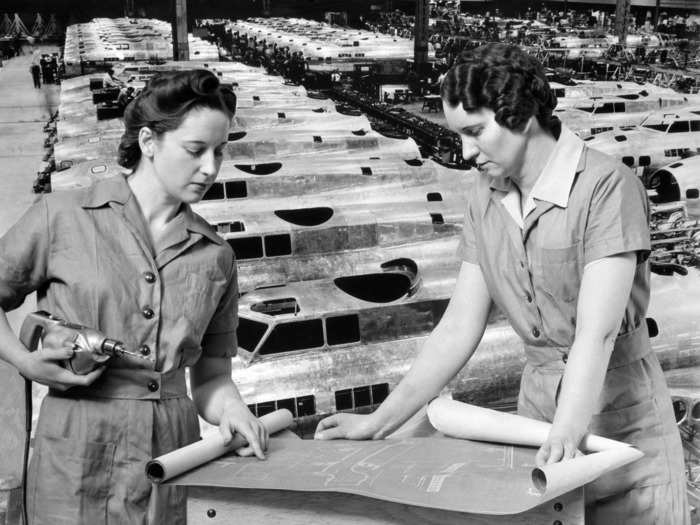
Utility clothing dominated fashion before WWII ended in 1945. Uniforms were part of daily looks due to rationing within the US and were seen at "all civilian social occasions from cinemas, weddings, restaurants, and gala events," according to Fashion Era.
Refined, practical, and unadorned, the typical look for women was "padded shoulders, a nipped-in waist, and hems to just below the knee" in denim, seersucker, or jersey materials, according to FIT. While working in factories, women also wore turbans to keep their hair safely back and wedge heels to prevent pain.
Christian Dior's "New Look" in the '50s brought feminine, full-skirted silhouettes to the decade.
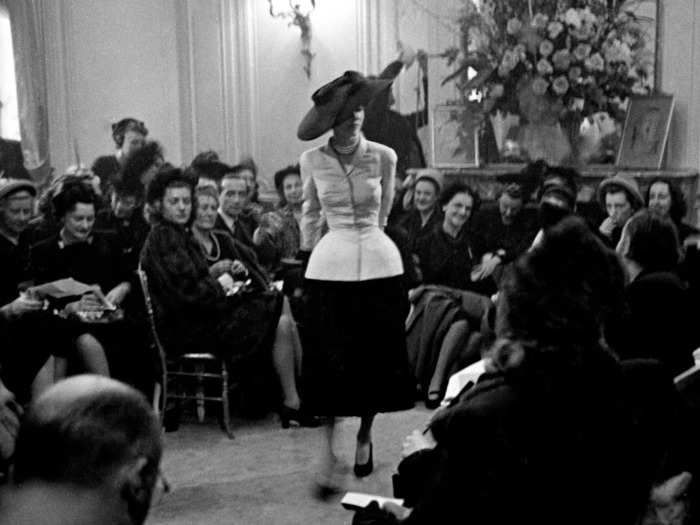
The "New Look" silhouette, which featured a small waist with full hips, was introduced by Christian Dior in 1947 but came to define the 1950s. The post-war collection consisted of a pre-war look with hints of the Victorian era and informed the overall full-figured silhouettes of the '50s.
Throughout the decade, there was more opportunity for people to make choices rather than follow one trend. While some preferred "New Look" dresses, others opted for straight-cut suits and narrow sheath dresses that came out mid-decade, or the new cocktail-dress silhouette.
Meanwhile, youth culture and rock music also informed fashion with the likes of poodle skirts and fun plaid, floral, polka dots, and stripe prints.
The invention of the miniskirt came at a time of sexual liberation and youthful celebration: the '60s.
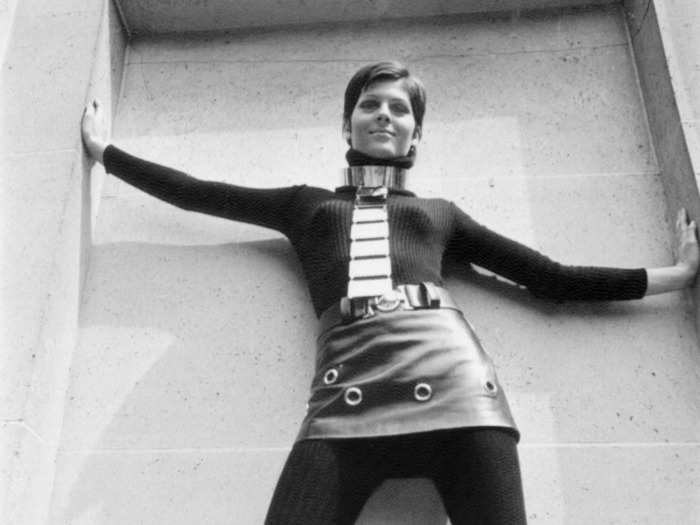
The 1960s had multiple fashion transitions and movements that defined it. Because some young people had a lot of disposable income since the war, they wanted to express their style.
From Jackie Kennedy's early boxy suit style to "Space Age" influences and color palettes, to the onset of the hippie aesthetic and psychedelic patterns, fashion dramatically evolved during the decade.
However, the most notable invention was the miniskirt, widely believed to have been created by British designer Mary Quant. She first displayed the skirt in her London boutique in 1964. A symbol of youth and sexual liberation, the skirts were often worn with equally fun colorful tights and boots.
Quant told The New York Times in 2003 that she created the design because Chelsea girls demanded them ... or they would just cut up her designs themselves. She then named her creation after her favorite car, the Mini Cooper.
"The mini-car went exactly with the miniskirt; it did everything one wanted, it looked great, it was optimistic, exuberant, young, flirty, it was exactly right," she said in the "Mary Quant, Mini Cooper, Miniskirt" documentary, as per the BBC.
Leisure suits of many forms were worn by both men and women in the '70s for a sophisticated yet casual look.
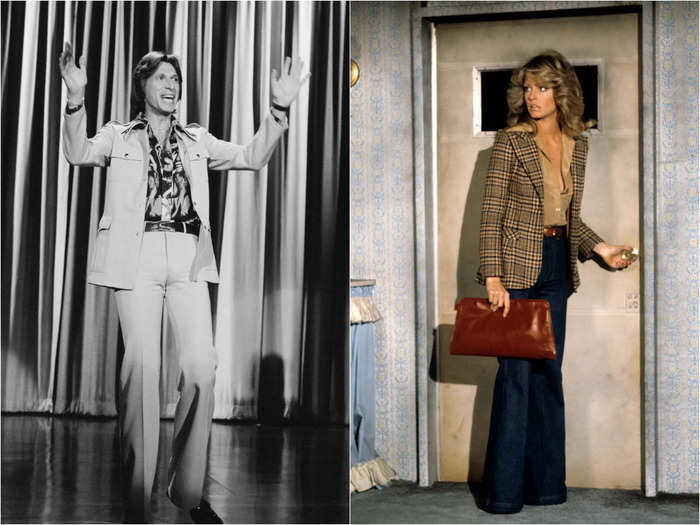
The 1970s likewise brought forth even more individuality, expression, and androgyny.
From the mid-'70s and on, "leisure suits" were the "it" items for both men and women. These pieces typically matched in color and fabric (e.g. polyester or velour) and were worn daily, outside of the office. Flared pants slowly got wider (before they got dramatically narrower later on in the 20th century).
According to a New York Times report, this was the most popular suit style for men in 1974, as per Insider.
It was also the first decade where women freely wore pants, taking inspiration from menswear. They participated in the trend of wearing flared trouser suits, which was popularized by "Charlie's Angels."
By the '80s, women began wearing padded-shoulder-and-skirt power suits to the office.
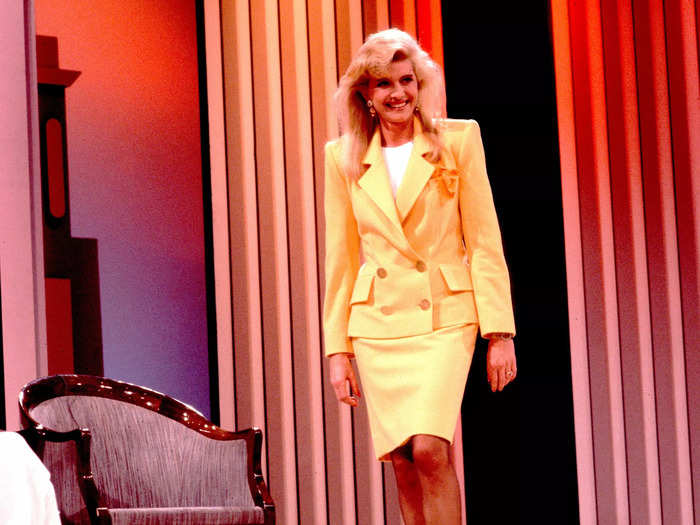
Power suits were the hot item for making women confident, and they "reflected a shift in women working in high-powered positions and using fashion to be taken seriously," according to FIT.
These suits initially had sportswear influences and neutral color palettes, but as the decade went on, they had blockier silhouettes, and jackets even had strong shoulder pads.
For women who felt long skirts were frivolous, they could opt for suits with pencil skirts or miniskirts instead. They paired their power suits with bold accessories and spiked heels.
The '80s shifted from neutral colors to bright neons to black-and-white solids. This was also reflected in gym-wear, dance-wear, leggings, and Lycra.
In addition to baggier silhouettes coming into fashion, brands like Ralph Lauren turned casual menswear staples into elegant womenswear, and started a preppy trend.
In the '90s, many teenagers owned flannels thanks to the grunge movement and their parents' closets or thrift stores.
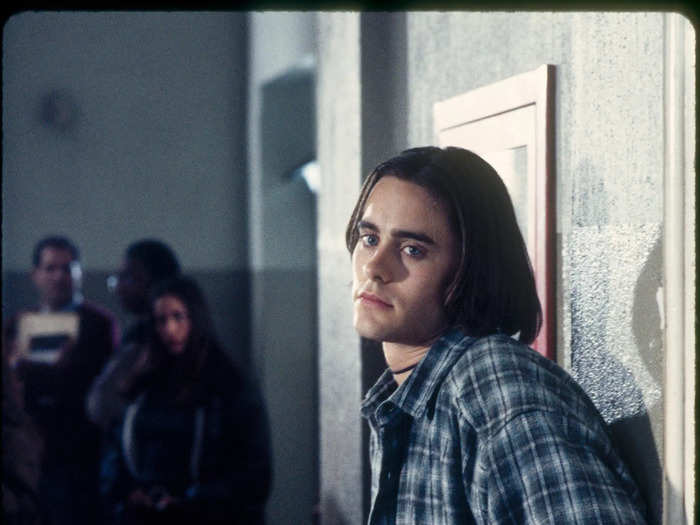
The 1990s started with a focus on minimalism. Grunge music and style emerged from Seattle in the late '80s and took over the '90s, thanks to angsty teenagers listening to Nirvana. Plaid flannels in different colors were commonplace and worn unbuttoned or tied around waists.
Many teens resorted to raiding their parents' closets or finding them in thrift shops. Dr. Marten boots, T-shirts, worn-out jeans, and slip dresses completed the grunge look.
Denim jeans went through several popular styles in the 2000s, but we could never escape them one way or another.
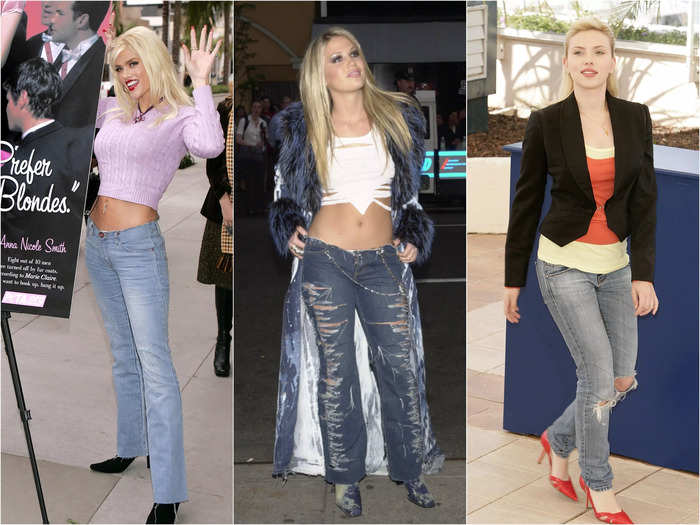
The closer we get to the present, the harder it is to see fashion's bigger picture and influence. But the must-have item of the 2000s has to be denim jeans, or denim in general, which went through its own notable evolution throughout the decade.
During the early-aughts bohemian trend, jeans were ultra-low-rise and flared, before the popular boot-cut style came out. Then in 2005, skinny jeans were introduced and they became overwhelmingly popular. Whether sleek or distressed, jeans became the go-to item to wear and were seen as appropriate for most occasions.
Britney Spears and Justin Timberlake's red-carpet denim-on-denim looks made jeans even more popular, and eventually led to the rise of denim miniskirts.
But we can't forget Juicy Couture sweatsuits, Von Dutch trucker hats, and more revealing clothes like crop tops, halter tops, and tube tops, which also defined the decade.
"Ugly" shoes were worn with athleisure by the masses and celebrities, especially thanks to high-profile collaborations, in the 2010s.
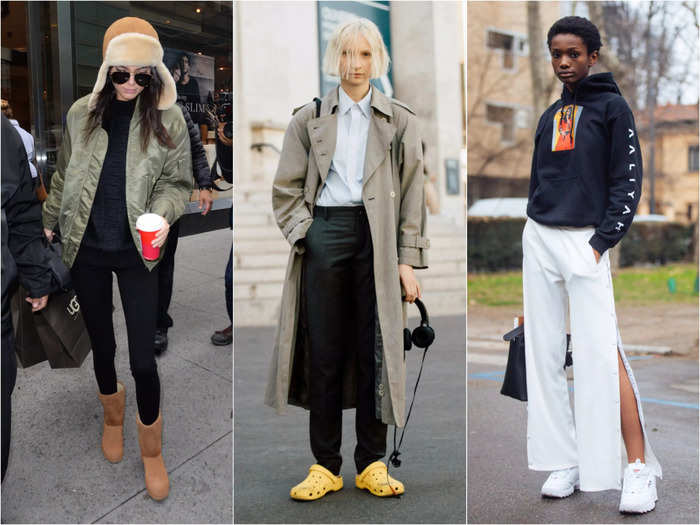
The 2010s were synonymous with the rise of athleisure. From leggings and yoga pants being worn outside of the gym to '90s streetwear brands being revived, a lean towards comfort was notable.
However, the biggest indication of this was through popular "ugly" shoes such as Ugg boots, Crocs, and chunky dad sneakers which all became coveted pieces.
Uggs were born in the 2000s, but high-fashion brands partnered with them and drove sales back up in the 2010s.
Crocs went from comfortable boat shoes to quirky grocery-getting shoes. And "dad shoes" such as '90s Fila Disruptors became popular with teenagers.
Luxury sneaker collaborations also helped blend streetwear and athleisure with high fashion, leading them to become "it" items.
READ MORE ARTICLES ON
Popular Right Now
Popular Keywords
Advertisement